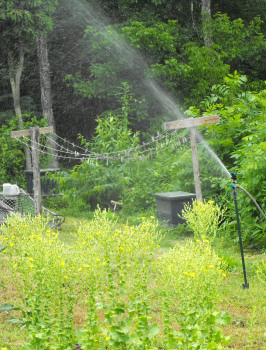
Build your garden infrastructure
 If
you're like me, planning is fun but you really want to start eating
your own tomatoes ASAP. My gardening advice for beginning
homesteaders is --- think big, start small.
If
you're like me, planning is fun but you really want to start eating
your own tomatoes ASAP. My gardening advice for beginning
homesteaders is --- think big, start small.
You will be a lot happier in the long run if you spend most of your
energy the first year working on garden infrastructure. Plan
permanent paths based on nodes,
and make sure that your paths are wide enough. I've found that
paths between garden beds should be about three feet wide to give me
room to easily maneuver a wheelbarrow, lawnmower, and garden cart
through them.
Think about irrigation from the beginning. We started planting
before we had any way to get water to our crops, so we ended up hauling
water in five gallon buckets from the creek. Don't repeat our
mistakes --- check out our irrigation
series for more information.
 Chances
are you're going to have to deal with deer or other animals nibbling
your crops. If you have a small garden, go ahead and put in the
time up front to build a fence. If your garden is going to be
large, like ours, now's the time to start experimenting with deer
deterrants
the way Mark has. There is nothing worse than waking up one
morning to find out that your carefully tended garden has been eaten
overnight.
Chances
are you're going to have to deal with deer or other animals nibbling
your crops. If you have a small garden, go ahead and put in the
time up front to build a fence. If your garden is going to be
large, like ours, now's the time to start experimenting with deer
deterrants
the way Mark has. There is nothing worse than waking up one
morning to find out that your carefully tended garden has been eaten
overnight.
When you are ready to plant, I highly recommend building
wall-less raised beds. Or, if you have access to the
materials, build
no-till raised beds
to protect your soil ecology. Raised beds are very energy
intensive at first, but they're good for your garden and will also
force you to start small.
You may also be dreaming of fruit trees. It can't hurt to put in
a few your first year, but make sure that you have time to take care of
the ones you put in. It's better to build a really good raised
bed for one tree the first year than to hastily throw ten trees in the
ground and watch them all die.
| This post is part of our Starting Out on the Homestead lunchtime
series.
Read all of the entries: |
Want more in-depth information? Browse through our books.
Or explore more posts by date or by subject.
About us: Anna Hess and Mark Hamilton spent over a decade living self-sufficiently in the mountains of Virginia before moving north to start over from scratch in the foothills of Ohio. They've experimented with permaculture, no-till gardening, trailersteading, home-based microbusinesses and much more, writing about their adventures in both blogs and books.
Want to be notified when new comments are posted on this page? Click on the RSS button after you add a comment to subscribe to the comment feed, or simply check the box beside "email replies to me" while writing your comment.

You are so right about this. Starting out slow can be key. The first year I double dug the bed by hand and had a small "permanent" raised bed for perennial vegetables (my asparagus) and then a 4 x 4 plot for vegetables a la square foot gardening. We've slowly expanded each year from there!
When we move out to the acreage we'll be able to plot out a larger garden area as well as a few acres of crops which will need to be rotated. Thankfully my husband has experience with the practical aspects, while I am good at sketching and planning. Always have a steno notepad at hand!
Always have a steno notepad at hand!
Angela <><